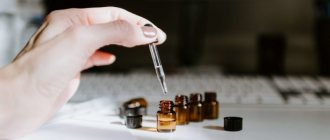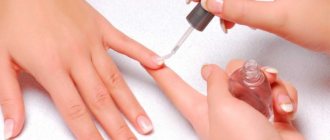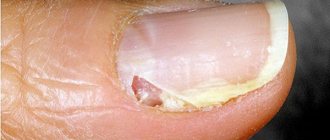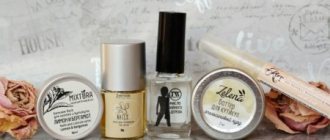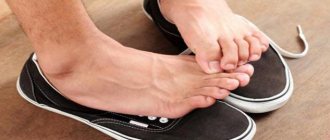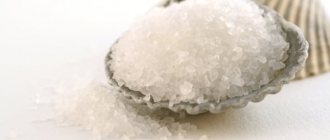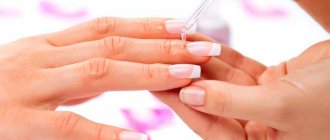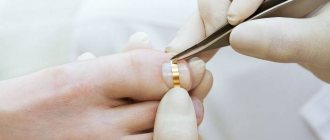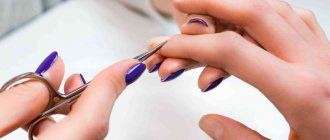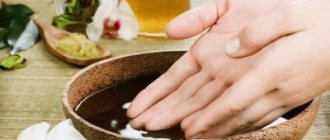Tea tree essential oil for nails perfectly moisturizes, cleanses, nourishes and has a number of other positive effects. Tea tree essential oil has been known for a long time; its antiseptic properties were widely used in medicine before the discovery of antibiotics. After the discovery of antibiotics, the popularity of this oil gradually waned, but the benefits remained.
Causes of infection on the nail plates of the feet and hands
Most often, nail fungus passes to a healthy person from an infected person. Typically, a fungal infection lives in rooms with high humidity and temperature (saunas, swimming pools, showers).
The matter is complicated by the fact that most varieties of fungi can live for some time outside the host, for example, in the soil. But when exposed to ultraviolet light, microspores quickly die. For people prone to hypochondria, it will be a fear to learn that pathogenic fungal flora surrounds us everywhere. But only 25–30% of the total population suffers from fungal diseases.
People with low or weakened immunity that cannot cope with the infection are susceptible to infection. As soon as it penetrates the nail plate, an active reproduction process immediately begins. So, without additional immune support, it will be almost impossible to cope with this disease. As long as the fungus tries to gain a foothold in the patient’s body, the immune system will try to overcome it.
A sharp decrease in immunity (and, accordingly, possible infection with a fungus) occurs when:
- regular and severe stress;
- improper sleep and rest patterns;
- diabetes mellitus;
- hepatitis;
- hormonal imbalance;
- dysbacteriosis;
- skin diseases;
- limb injuries;
- recovery after a prolonged cold or surgery.
In most cases, you can understand that a fungus has settled in the body almost immediately after infection:
- First, the pathology will affect the thumbs and/or little fingers, the nails will become dull, and characteristic yellow spots and plaque will appear on them.
- The skin around the nail plates will begin to itch, turn red, and an unpleasant sour smell will emanate from the fingers.
Important! Lack of timely treatment will lead to the pathology affecting internal organs, causing various complications.
Watch the video about the causes of fungus below.
Possible complications
Some possible complications after a fungal infection:
- infection of internal organs and third-party body systems;
- a sharp decrease in immunity;
- exacerbation of chronic diseases;
- deformation of the nail plate;
- depression;
- deformation of fingers (arthritis, flat feet);
- allergic manifestations of various types.
Important! Ignoring therapeutic measures will lead to the development of complications after several years of infection progression.
However, in the presence of chronic diseases of any nature, changes in immune status can occur much faster (in several months, for example). At the same time, both the fungus and the complications it causes will progress.
A large number of people today have managed to appreciate the benefits and miraculousness of tea tree oil. Synthetic substitutes and analogs have long gone by the wayside due to side effects that outweigh the benefits.
Tea tree oil, when used correctly, can help with many ailments and diseases.
Where did it come from? The tea tree grows on the coast of Australia. It was there that Cook brewed tea from it, not yet knowing about the capabilities of this oil. After a while, research began on the properties of this amazing tree, or more precisely, the essential oil that can be obtained from it.
By the way, this oil is not so easy to obtain. From one hundred kg of raw materials, only one kg of oil can be obtained. There is cold pressing and evaporation. The first option, of course, does not affect the quality of the essential oil. But the second one is much cheaper. Based on this, you can understand that the price of natural and high-quality tea tree essential oil cannot be low.
How can you use tea tree oil? Scientists have conducted numerous studies, as a result of which it became known that tea tree oil, when properly prepared, can have a healing effect on the body. Currently, tea tree is used for nails, since all kinds of synthetic ointments and creams for several months are not able to cure fungus in some cases, but tea tree oil copes with this task in a couple of weeks.
Tea tree oil has proven to be an excellent antiseptic, antiviral and anti-inflammatory agent. It has become indispensable for respiratory diseases. Protracted diseases of the respiratory system stop tormenting a person after he begins to inhale aromatic oils every day and apply warming creams to the chest area with the addition of a couple of drops of concentrated tea tree oil.
The very top layers of the skin can be nourished with vegetable oils, which cannot penetrate deeply. But to nourish the deepest layers, you will need essential oil. But it must be applied very carefully, otherwise, if you are careless, you can get burned by concentrated tea tree oil. In advance, you need to apply a drop of oil to your wrist or elbow, rub in and leave for a day. This is a test for a possible allergic reaction. If no changes occur during the day, then there is no allergy and you can safely continue to use it.
Using face masks, nourishing creams or other cosmetics, you can add a drop of oil to them, and then not only the upper but also the deep layers of the skin will be nourished. This means that this oil has the ability to preserve beauty and youth.
As for its unique property, tea tree oil is used for nails in the fight against fungal diseases as follows. First you need to steam your feet or hands in water, clean them, treat them with a file, dry them and apply concentrated tea tree oil to the nail plate so as to thoroughly saturate the nail, and also treat the edges. But you need to handle it very carefully so as not to get it on your skin. The result will not take long to arrive. Soon there will be no trace of the fungus left.
In order to restore and improve your hair, it is enough to use the oil in combination with shampoo, or even better, make nourishing masks with a drop of tea tree oil. Tea tree oil for nails can also restore the cuticle and improve the growth of the nail plate.
It is impossible not to take into account the fact that tea tree oil has an immunostimulating effect. During epidemics, it must be used and then all these ailments will bypass.
This miraculous oil helps not only in winter, but also in summer. During active summer, aromatic oils can drive away insects. And the bites of wasps, mosquitoes and horseflies, which cause redness and itching, can be avoided by immediately applying the oil to the affected area.
You can use not only tea tree, nail oil. After all, all kinds of creams, oils, balms, tonics and lotions containing tea tree oil to combat oily skin are now very popular. Surprisingly, it can tighten pores, fight acne and clear the face of acne.
The beauty of her hands is very important for a woman. Well-groomed and beautiful fingers are always visible and attract attention. While waiting for them to be even more beautiful, it is worth taking care of your natural nails and their health. We figured out that tea tree oil helps get rid of fungus. Prevention of fungal and infectious diseases is also achieved through the use of tea tree.
It happens that after using acrylic or gel nails for a long time, you want to return to natural beauty. Tea tree oil will help restore the nail plate. The method of application is to prepare a bath of half a liter of water at a fairly high temperature, to which you need to add sea salt and five drops of concentrated oil. You need to hold your hands for about 20 minutes. Then dry and apply tea tree cream. Sometimes you can use nourishing masks consisting of three parts olive oil and one part butter. This mixture of oils must be rubbed into the nail plate.
Tea tree oil should always be in your medicine cabinet. There is no need to look for cheap and synthetic analogs that can make the situation worse. Purchasing natural oil will give health to your nails and body.
Properties of the drug
Tea tree oil is an extract from melaleuca, a tropical shrub. This drug contains more than 96 substances that can combat pathogens. Essential oil is used to combat various bacterial infections (including nail fungus).
Numerous studies have proven the effectiveness of tea tree oil in the treatment of onychomycosis of varying severity.
Properties of the drug (in the fight against onychomycosis):
- Antifungal (fungicidal) . The active substances included in the product suppress the activity of fungal infection strains and destroy the mycelium. This effect is mainly associated with the activity of terpenes, the concentration of which in the ether reaches approximately 40%.
- Antimicrobial (antibacterial) . The oil prevents the proliferation of most pathogenic microorganisms, including staphylococci, streptococci and even E. coli. In addition, the antibacterial effect prevents the development of purulent complications.
- Disinfectant. The extract has a strong antiseptic effect.
- Anti-inflammatory and soothing. Tea tree essential oil helps boost local immunity, relieve inflammation, burning, itching and even pain in the affected areas.
- Immunostimulating. The oil helps boost immunity, preventing re-infection and speeding up recovery after illness.
- Nourishing and strengthening. Tea tree oil helps restore damaged nail structure, accelerates the growth of healthy parts, and makes nails strong and shiny.
Attention! It has been proven that tea tree oil helps not only with infections of a fungal nature, but also with skin diseases, dry dermis, brittleness and hair loss. There is even a claim that this drug fights cancer cells.
Features and Benefits
Tea tree essential oil is one of the best antiseptics given by nature. It copes well with fungal nail infections - onychomycosis.
Benefits of using tea tree ether in the fight against fungal infections and nail care:
- Prevents delamination.
- Accelerates plate growth.
- Stops fragility.
- Moisturizes the cuticle.
- Fights fungal microorganisms.
- Makes the nail plate smoother.
- Prevents the formation of hangnails.
When is the best time to treat with this remedy?
The drug will give the best effect when used in the early stages of the development of a fungal infection of the nail plates. It will help slow down the growth and spread of pathogenic flora and block its transition to healthy areas of the nail.
The product also works great in preventing re-infection with the fungus and during rehabilitation after an infection.
The oil restores the nail, strengthens and nourishes it. If onychomycosis has been neglected, then tea tree essential oil is unlikely to help cure it. If the disease is advanced, you should seek help from a specialist who will prescribe antifungal ointments, tablets, and immunomodulators to increase the body's protective functions. At this stage, you can use the oil as a local preparation to relieve itching, pain and inflammation.
Local baths for the treatment and prevention of foot and nail fungus
baths for the treatment of nail fungus
The use of therapeutic foot or hand baths helps in the treatment of oniomycosis as an auxiliary measure. After the procedure, the nail or skin is lubricated with pure tea tree essential oil or external pharmaceutical products prescribed by a doctor (varnish, gel, ointment, cream, spray, liquid, etc.).
To prepare a bath, dissolve a tablespoon of honey and the same amount of baking soda in one and a half liters of hot water. Separately, add 20 drops of tea tree essential oil to a quarter glass of sea salt. Next, the salt is poured into water, dissolved, and the feet or hands are immersed for a quarter of an hour.
Baths with a medicinal composition are suitable both for treatment and for the purpose of preventing the occurrence of fungus, for example, after visiting a pool or sauna.
Contraindications for use
Before starting treatment of onychomycosis with ether, you should definitely consult a doctor and also take into account some contraindications:
- individual intolerance to the drug;
- increased sensitivity of the skin;
- allergic reaction to the drug;
- age up to 6 years;
- pregnancy;
- lactation period.
Only an experienced mycologist can calculate the correct dosage of the product. He will tell you how to use the drug most effectively at your stage of pathology development, and will also prescribe concomitant therapy that will speed up treatment.
How exactly to use tea tree oil for nail fungus
Tea tree ether is a highly concentrated product.
Before first use, an allergy test is performed. Before use, apply the oil to your wrist and wait. If redness and burning occurs, then the product is not suitable.
Allergies can be caused by the intense odor of the oil. The test for odor intolerance is simple:
- Apply 1-2 drops of oil to a handkerchief.
- Apply to your nose throughout the day.
If no side effects are noticed, then there is no allergic reaction to the drug. If nausea, dizziness or other unpleasant symptoms occur, it is not advisable to use this drug.
For treatment to be effective, the permeability of the plate must be improved. To do this, the nails are steamed before the procedure.
For most procedures, tea tree oil for nail fungus is used undiluted. In case of increased sensitivity, it is diluted with one of the base oils: sunflower, peach, sea buckthorn or olive
If oil is used in its pure form for procedures, the course of treatment should not exceed 2–3 months.
How to use for treatment?
Tea tree oil can be used in several ways:
- diluted for rubbing;
- in its pure form for massage;
- as the main component for lotions or compresses;
- for making ointment;
- as an additive to medicinal baths;
- for the production of antimicrobial socks.
Important! Do not ingest tea tree essential oil under any circumstances! It is intended for external use only.
Check out the video below on treating fungus with tea tree oil.
Rubbing in diluted form
Most often, the drug to combat fungal infections is used in diluted form. This allows you to reduce the concentration of active substances in the composition and minimize the risk of side effects.
You can prepare the mixture in the following way:
- The basis is unrefined olive, coconut or other vegetable oil.
- Tea tree oil is added to it in a 2:1 ratio. You can take a standard recipe in which olive oil, thyme and tea tree oil are mixed in proportions of 2:1:1.
- The resulting mixture should be applied liberally to the nails and the skin around them using a cotton swab or cotton pad.
- The applied product is rubbed in using a special pedicure brush with massage movements until it is completely absorbed.
- 15–20 minutes after grouting, you need to apply an adhesive plaster or a tight bandage.
Important! The procedure is carried out twice every day (including at night).
Rubbing in its purest form
In its pure form, the oil is used only for chronic types of the disease, as well as in advanced cases:
- Apply 2 drops of undiluted tea tree oil to each nail. It is best to apply the product with a pipette.
- The composition is rubbed into the nail using a swab or cotton swab. It is not recommended to go on skin.
- After grouting, wait 8-10 minutes and then apply a bandage or tape over your nails.
The procedure is carried out twice a day, the last one is done before going to bed.
Compresses
It is also recommended to use melaleuca oil as a component for lotions in advanced cases:
- Undiluted ether is applied to a cotton swab, which, in turn, is applied to the affected nail plates for 10–15 minutes. The product must not come into contact with the skin.
- After removing the compress, do not wash off the product.
- You need to carry out the procedure twice a day, the second one before bedtime.
Ointment
To prepare an ointment based on tea tree oil, you will need an antifungal ointment prescribed by your doctor:
- The antifungal cream is squeezed out of the packaging onto a saucer.
- Add 1-2 drops of melaleuca extract to it.
- The finished mixture should be applied with massage movements into the nail and the skin around it.
This external treatment option is most often prescribed by mycologists. It is considered more effective than using a cream or essential composition in its pure form.
Antibacterial socks
The method works well as a preventive measure against re-infection:
- Take any clean cotton socks.
- Spray them with melaleuca ether to cover a large area.
- Ready socks should be worn over clean ones at night.
- Rinse your feet in cool water in the morning.
Essential baths
Baths not only have a disinfecting effect, they also soften tissues and accelerate the absorption of medicinal antifungal drugs. So it is best to carry out such procedures before applying the main treatments:
- Heat 2 liters of clean water to 45 degrees.
- Add 10-12 drops of tea tree ether to them. If you have the desire and opportunity, you can add an additional 1 tbsp to the mixture. a spoonful of sea salt and 2 tbsp. tablespoons of soda, 1 teaspoon of hydrogen peroxide and the juice of 1 lemon, or only 4 teaspoons of liquid soap.
- Immerse your feet completely in the solution and steam for 15–20 minutes.
- After steaming, remove the keratinized layer of nails with a file, wipe your feet dry and treat the nail plates with antifungal ointment and/or melaleuca oil.
Important! Such baths are recommended to be carried out once a week, but daily use is also allowed.
Benefits of oil for fungal diseases
Tea tree oil is obtained from the branches and leaves of the melaleuca tree, which is native to Australia. The product is obtained by steam distillation, which preserves all valuable substances.
During World War II, tea tree oil was considered a strategic military medicine stockpile.
Tea tree oil contains about 50 biologically active substances. Its powerful antiseptic effect has long attracted the attention of Australian aborigines, and in the twenties of the last century the industrial use of the product began.
The chemical composition of tea tree essential oil provides the medicinal properties of the product
The oil has the following properties:
- antimicrobial;
- anti-inflammatory;
- antiviral;
- antifungal.
When treating a fungal infection with tea tree oil, the external manifestations of the disease (itching, peeling, destruction of the nail plate, unpleasant odor, etc.) disappear, and the growth and reproduction of microorganisms that provoke the development of the disease are blocked.
Video: beneficial properties of tea tree oil
Useful tips
In order to get rid of onychomycosis as soon as possible and consolidate the therapeutic result, it is necessary to prevent re-infection. The following measures are taken as preventive measures:
- Careful monitoring of the sterility of towels, shoes and bed linen.
- Change socks twice a day.
- Dirty laundry should be washed at high temperatures and ironed thoroughly afterwards.
- After visiting a public swimming pool, sauna or gym, you need to treat your feet with an antifungal drug.
- Clean and disinfect shoes regularly using specialized sprays.
- Do not touch railings, open objects in public places, or handrails unless absolutely necessary.
Melaleuca or tea tree oil is an affordable and yet effective time-tested method of treating nail fungus. The product is sold in any pharmacy, has a low cost and a limited number of contraindications. It works great in the early stages of the disease and allows you to defeat mycosis and grow a healthy nail in just a few months of regular treatment.
Be sure to consult with your healthcare professional before using essential oils.

